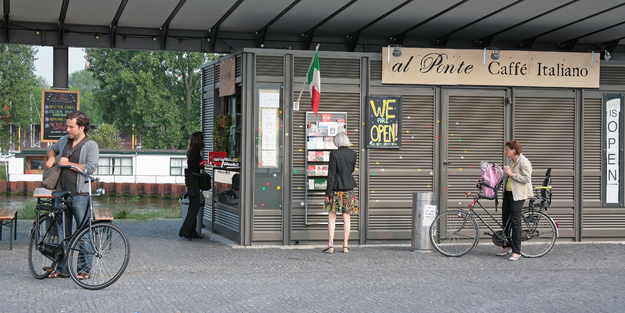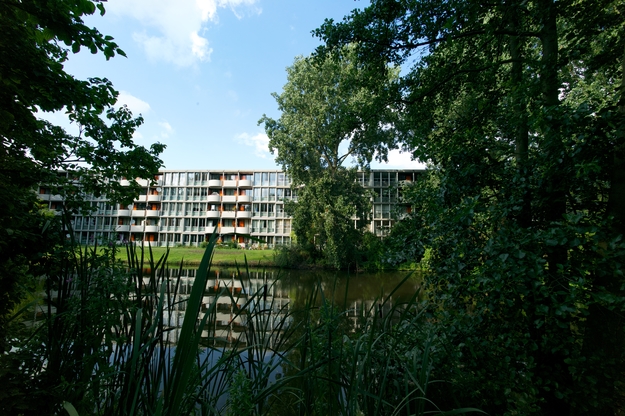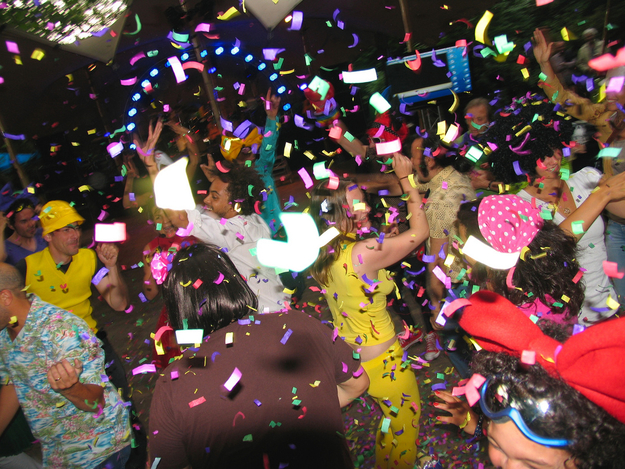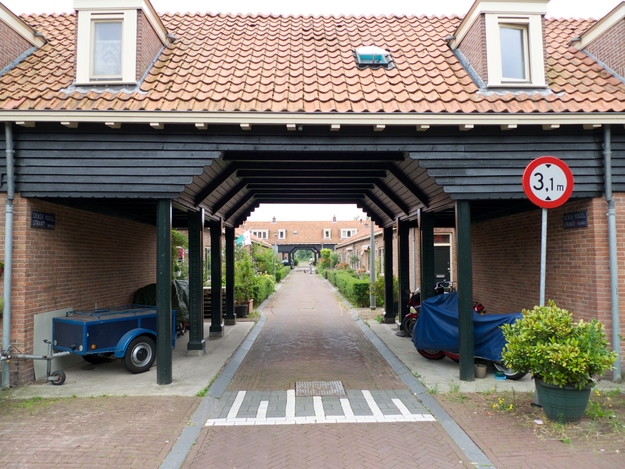1. Al Ponte
At this ferry jetty on the IJ-plein you'll find the Italian coffee stand Al Ponte. Start the day with an excellent espresso or cappuccino, and home-made pastries. Go straight and follow the bike path.
2. Volewijck
Halfway through the 19th century, you would have seen the peninsula Volewijck left of Meeuwenlaan, and the IJ to the right. Ever since the Oranje sluices were built (1865-1870) and the tide from the Zuiderzee ceased to influence the IJ, both sides of the peninsula are impoldered.
3. IJ-plein
The late 80’s neighborhood to your right is designed by O.M.A., Rem Koolhaas' architecture firm. Here lay the ADM-wharf, until its bankruptcy in 1985. Just a short while ago, this austere social housing was the only part of Noord where you could reside so closely to the IJ.
Continue on Meeuwenlaan.
4. Vogelbuurt
To your left, you see the remarkable green-blue tiled Moroccan mosque El Mousshine. The mosque lies on the border of the Vogelbuurt, where many laborers used to live, who worked at the docks on the other side of the Meeuwenlaan.
When you pass the parking lot of supermarket Dirk van den Broek turn right. Take the first left and go right again at the Opel Renault garage. Cycle through the second fence until you reach the IJ. A little further to your left you'll spot Hotel de Goudfazant.
Mosque El Mouhssinine - Mosque El Mouhssinine, at Adelaarsweg. Photo: Edwin van Eis, 2008.
5. Hotel de Goudfazant
Hotel de Goudfazant is neither a hotel, nor the stuffy place that its name may suggest. It’s a vibrant and extremely tasty restaurant with a view over the IJ.
Head back to the Opel Renault garage and take a right there. Go right once more at the T-junction, then take the first left. Vogeldorp appears on your left hand side.
6. Vogeldorp
Vogeldorp is an idyllic spot; a pixie village with tiny houses and streets, once built as an emergency village (an inexpensive neighborhood with crummy services, built to fight the housing shortage). As this shortage persisted over the years, it was renovated time and time again, so the village still exists.
Exit Vogeldorp on the North side, there where you can see the allotment gardens, and take a right. Turn left at the T-junction.
7. Sulfuric Acid
The awesome bundles of pipes belonging to the chemical installation you see now, are those of Alblemarble, formerly known as Akzo Nobel. A long time ago Ketjen's sulfuric acid factory stood here. To protest the threat of poisonous gasses, the surrounding neighborhoods set up an action committee called Tegengif (Counter agent). Thanks to their opposition, the decision was made to have the Vliegenbos function as a green buffer, in case poisonous gasses would pollute the air.
Follow the road and keep the Vliegenbos to your left. Take a left by the water, follow the road up the dike, and then take a right.
8. Nieuwendammerdijk
Perhaps the most picturesque part of Amsterdam. A typical Dutch development from the late Middle Ages. With wooden Zaandam-style houses, a sluice, windmills and its very own tiny port. A ferry to Central Station used to depart from there. The ferry was the most important means of transportation for the Noord commuters. The boats were known to be so punctual, that the Nieuwendammerboat functioned as a wrist watch for the people of Nieuwendam. Mothers told their kids to count the number of ferries in order to see until what time there were allowed to stay out. Take a left, and turn left on the first street you see.
9. Tuindorp Nieuwendam
This garden city is built for the working class. Until World War II broke out, it was seen as the prettiest of its kind in all of Europe. A garden city is a neighborhood with a typical countrified character. Many of them are built as an alternative to the impoverished housing of the larger cities’ working class. At the time, there were even Frenchmen and Brits visiting Nieuwendam to find out more about this phenomenon. Take a good look around, also down the smaller side roads and alleys, and discover how the infrastructure is made up of different spaces, varying from the great central square to the small-scaled courtyards.
10. Herring stall
Now that you’re in Nieuwendam, you might as well try the typical Dutch ‘herring with onions’ at fish stall Naatje on Purmerweg.
Follow Purmerweg westward until you see a big pond to your right. After passing the pond, take a right.
11. Gool's plan / Het Breed
These housing blocks from 1960 seem to be made up of a bare concrete structure, filled in later with residences. On the fourth floor, the blocks are connected through elevated bridges, strongly resembling the gateways of Schiphol (also designed by architect Frans van Gool). The first inhabitants of the buildings were middle class starters, young academics, and creative people, making this a very lively and hip neighborhood at the time.
Head back to the road you just turned off and continue in the same direction. Pass through the bike tunnel on the left, and immediately take a right. Cycle past the two roundabouts and turn right after passing the row of houses.
12. Buiksloterdijk
If you ride further westwards under the highway, you'll end up on the Buiksloterdijk. Just like Nieuwdammerdijk, this dike is part of the Waterland sea dike built in the Middle Ages to protect the back country against water from the Zuiderzee. Turn left at the end of the ditch to your left. Cycle towards Florawijk and take a left after five blocks. Florapark lies left of Florawijk.
13. Florapark (from 2011 on Noorderpark)
Florapark (1921) was dug in the style of an English landscape park, an idealization of nature with the accent on picturesque and romantic aspects. Slanted pastures, ponds and views of remarkable landscape features like pavilions, fountains and sculptures. In Florapark you’ll find the Noorderparkkamer, a pavilion and stage, where events are organized for people of all ages. Exit Florapark in the south and take the underpass. Directly on the other side, you’ll find Mosveld to your right.
14. Mosveld
Every Wednesday, Friday and Saturday you'll find one of Amsterdam’s cheapest markets here. The market has everything you'd ever want: fresh foods and clothing, but also tools.
15. Van der Pekbuurt
Adjacent to the Mosveld lies Van der Pekbuurt, named after architect Jan Ernest van der Pek. The neighborhood was built between 1920 and 1930 and housed many poor people who came from slums in the Jordaan. The neighborhood became more and more popular, and has had a mixed population ever since.
Exit Van der Pekstraat southbound. Follow the road until you spot the gate of Tolhuistuin to your right.
16. Tolhuistuin
Until a couple of years ago, this was still the heavily guarded main entrance of Shell. Behind the high and pointed gates now lies a little hidden paradise. An intimate park where, during the summer, you can listen to music and watch theater all weekend. End your trip at the Tolhuistuin, or on the Ponthuys terrace.



